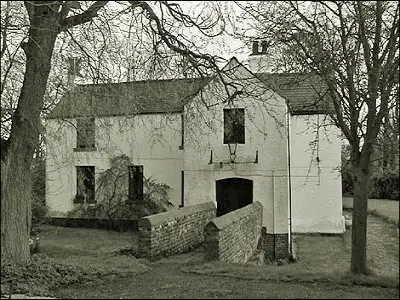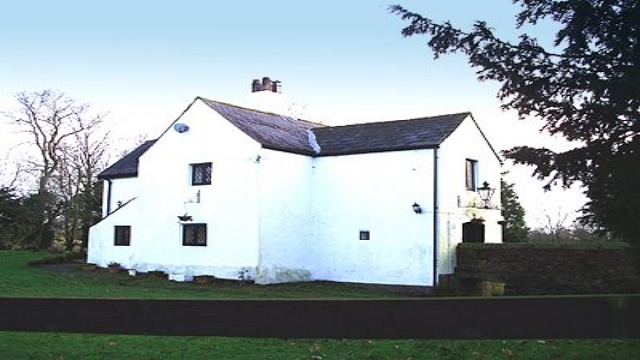Nestled near Preston in Lancashire, Chingle Hall is not only one of England’s oldest brick buildings but also one of its most haunted. Built in 1260 by Sir Adam de Singleton, this historic manor has witnessed centuries of history—and, according to many, centuries of supernatural activity.
From ghostly monks to mysterious fires, Chingle Hall’s eerie reputation has made it a magnet for paranormal enthusiasts. Let’s explore the chilling tales and dark secrets that make this ancient house a hotspot for ghostly encounters.
A History Steeped in Mystery
Chingle Hall, originally known as Singleton Hall, was constructed by the Singleton family, who owned the land since 1066. The house remained in their possession for generations before passing to their relatives, the Walls.
The hall’s great room is a focal point of intrigue. Its wooden cross beams, carved with unusual symbols, were tested by archaeologists and found to originate from an ancient Viking longboat. This discovery adds another layer of mystery to the hall’s already rich history.
The Ghosts of Chingle Hall
Chingle Hall is said to be home to numerous spirits, each with its own story. Here are some of the most famous:

1. John Wall: The Martyred Priest
One of the most prominent ghosts is Father John Wall, a Catholic priest during the Reformation. Born at Chingle Hall, Wall was forced to conduct secret masses due to the persecution of Catholics. In 1679, he was arrested, tried for heresy, and executed.
Legend has it that Wall’s severed head was returned to Chingle Hall, where it remains hidden—either buried on the grounds or concealed within the house itself. Visitors and paranormal investigators have reported sightings of his ghost, often accompanied by the scent of wood smoke.
2. Eleanor Singleton: The Tragic Captive
The most haunted room in Chingle Hall is said to be Eleanor Singleton’s chamber. According to legend, Eleanor was held captive in this room for over 12 years before her death at the age of 20.
Those who enter the room often describe an overwhelming sense of sadness and the faint aroma of lavender. Some visitors have even fainted, overwhelmed by the room’s eerie atmosphere.
3. The Dizzy Man and Other Spirits
Chingle Hall’s ghostly residents aren’t limited to its human history. Among the reported apparitions are:
- Monks: Believed to be connected to the hall’s use as a secret place of worship.
- Children: Their laughter and footsteps are often heard echoing through the halls.
- A Chimney Sweep: Seen in shadowy form, carrying out his duties.
- A Cavalier: A figure from the English Civil War era.
- The Dizzy Man: An entity known for causing disorientation and unease.
The Mysterious Fire
In the 1950s, one of the ancient Viking beams in the great room suddenly caught fire. Strangely, the flames seemed to extinguish themselves before reigniting into an uncontrollable blaze.
Was this a random event, or was someone—or something—watching over the hall? Many believe the fire was a supernatural occurrence, adding to the hall’s reputation as a place where the past never truly fades.
Visiting Chingle Hall
Today, Chingle Hall is a private residence, but its haunted history continues to draw interest. While public access is limited, the hall has been the site of numerous paranormal investigations.
Visitors and investigators alike report:
- Unexplained noises: Footsteps, whispers, and distant laughter.
- Shadowy figures: Apparitions moving through rooms and corridors.
- Cold spots: Sudden drops in temperature, often accompanied by a feeling of dread.
Why Chingle Hall Stands Out
What makes Chingle Hall one of England’s most haunted houses? It’s not just the age of the building or the number of reported ghosts. It’s the layers of history—each era leaving its mark, both physically and spiritually.
From its origins as a medieval manor to its role as a secret Catholic sanctuary, Chingle Hall has been a witness to joy, tragedy, and everything in between. It’s this rich tapestry of human experience that seems to have drawn so many spirits to its walls.
Final Thoughts
Chingle Hall is more than just a historic building; it’s a place where the past feels alive—sometimes uncomfortably so. Whether you’re a believer in the paranormal or a skeptic, there’s no denying the hall’s ability to captivate and unsettle.
If you ever find yourself near Preston, take a moment to reflect on this ancient house and the stories it holds. Just remember: some secrets are best left undisturbed.
Have you visited Chingle Hall or experienced its ghostly tales? Share your thoughts in the comments below!

